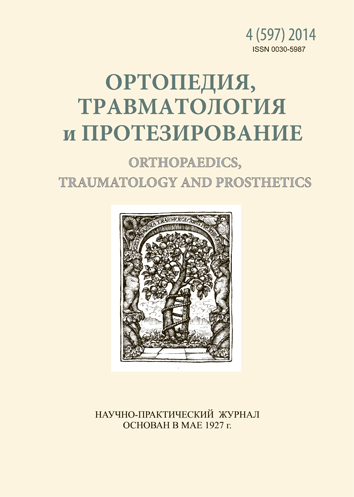Mathematical modeling of options for osteosynthesis of middle third clavicle fractures
DOI:
https://doi.org/10.15674/0030-5987201445-13Keywords:
clavicle, fracture, osteosynthesis, modelingAbstract
Fore consolidation of the clavicle fragments and restoration of function in damaged extremity it is necessary to create optimum conditions including an accurate comparison of bone fragments, their reliable fixation, following the rules of asepsis, preservation of blood circulation, active management in the postoperative period. We propose to use this lock original design. Purpose: mathematical model to conduct a comparative analysis of the stress-strain state (SSS) system «collarbone – implant» fracture in the middle third of the clavicle in a different osteosynthesis holders. Methods: mathematical models clavicle fracture with the middle third. Simulated three options osteosynthesis: extramedullary plate, intramedullary nail, the original design of the machine. VAT study models performed using the finite element method. In the first stage studied VAT system «collarbone – implant» under the influence of compressive loads, the second — bending, the third — twisting. Results: It was found that the most dangerous loads are bending. Stresses in the clavicle bone in flexion, may exceed the limit of its strength and cause fractures. Extramedullary plate works well only when the bending loads acting perpendicular to its plane. But if they are parallel to the plane of the plate, the entire burden falls on the extreme screws, and critical to the strength of the bone stresses occur is around them. Intramedullary rod is equally effective when bending loads that act in both vertical and horizontal planes. However, the stresses in the bone cell models are too high. Advantage copyright apparatus is that it keeps the load bending in any direction and prevents overloading the bone.
References
- Postacchini F., Gumina S., De Santis P., Albo F. Epidemiology of clavicle fractures // J. shoulder elbow surg. 2002. - V.l 1. - №5. - P.452-456.
- Matelenok EM, Barış AE Extrafocal transosseous osteosynthesis in the treatment of clavicular fractures // Orthopedics, Traumatology and protezirovanie.-1998.-№2.-S.100-102.
- Lunev AP Biomechanics of the shoulder girdle in fractures of the clavicle and surgical treatment // Author. dis. . cand. honey. Sciences. Odessa, 1971. 15 s.
- Orthopaedic Key Review Concepts by Kingsley R. Chin // Publisher: Wolters Kluwer/Lippincott Williams & Wilkins; 1ST edition (2007) //ASIN: B0022T7YR4 // Pages: 526.
- Klimovitskiy VG, Blackie VY The frequency of delayed consolidation of fractures in the affected different age groups and the influence of osteotrophic therapy. // Injury. - 2011. - Volume 12, №3. S.93-97.
- Korzh AA Belous AM, Pankow EY Reparative bone regeneration / AMS USSR. - M .: Medicine, 1972. - 232 p.
- Anqing LN, Levitsky VB Principles of stable functional osteosynthesis. - 1991 - 143.
- Lavrishcheva GI On the possibility of an impact on the rate of recovery of normal bone structure after fracture and the principles of morphological evaluation // Medical rehabilitation of patients with fractures and orthopedic diseases: Sat. tr. CITO. - M., 1983. - Vol. 26. - P. 6-10.
- Berezovsky VA, Kolotilov NN Biophysical characteristics of human tissue: A Handbook. - K .: Naukova Dumka, 1990. - 224 p.
- Zenkevich DC The finite element method in engineering - M: Mir, 1978. - 519 p.
- AA Alyamovsky SolidWorks / COSMOSWorks. Engineering finite element analysis / AA Alyamovsky. - M .: DMK Press, 2004. - 432
Downloads
How to Cite
Issue
Section
License
Copyright (c) 2014 Mykhaylo Karpinsky

This work is licensed under a Creative Commons Attribution 4.0 International License.
The authors retain the right of authorship of their manuscript and pass the journal the right of the first publication of this article, which automatically become available from the date of publication under the terms of Creative Commons Attribution License, which allows others to freely distribute the published manuscript with mandatory linking to authors of the original research and the first publication of this one in this journal.
Authors have the right to enter into a separate supplemental agreement on the additional non-exclusive distribution of manuscript in the form in which it was published by the journal (i.e. to put work in electronic storage of an institution or publish as a part of the book) while maintaining the reference to the first publication of the manuscript in this journal.
The editorial policy of the journal allows authors and encourages manuscript accommodation online (i.e. in storage of an institution or on the personal websites) as before submission of the manuscript to the editorial office, and during its editorial processing because it contributes to productive scientific discussion and positively affects the efficiency and dynamics of the published manuscript citation (see The Effect of Open Access).














